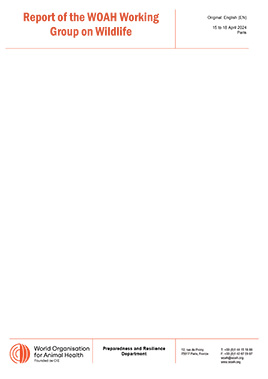| World Organisation for Animal Health |
|
WOAH
The World Organisation for Animal Health (WOAH) Founded in 1924 as the Office International des Epizooties (OIE), in May 2003, they adopted the common name World Organisation for Animal Health. An intergovernmental organisation, WOAH focuses on transparently disseminating information on animal diseases, improving animal health globally and thus build a safer, healthier and more sustainable world.Their mission is to improve animal health globally, thereby ensuring a better future for all. As part of that mission WOAH collects and analyses the latest scientific information on animal disease control. This information is then disseminated globally to improve the methods used to control and eradicate diseases. Guidelines are prepared by the network of 246 WOAH Collaborating Centres and Reference Laboratories across the world. Scientific information is also disseminated through various works and periodicals published by WOAH, notably the Scientific and Technical Review. On this page you will find a collection of valuable publications produced by WOAH. For more information or the World Organisation for Animal Health and its work, visit the WOAH website. For more on WOAH’s work with wildlife visit their Wildlife Health page.
Online articles and essential resources
Impacts of highly pathogenic avian influenza on wild birds - WOAH Bulletin Lessons learned in CITES: moving forward with biological sample shipment - WOAH Bulletin Wildlife health, biodiversity and climate change - WOAH Bulletin The history of WOAH’s involvement with wildlife and biodiversity - WOAH Bulletin Restoring biodiversity and wildlife through community action: non-human primates and riparian ecosystems Relevance of ecology and predictive modeling to wildlife health and biodiversity Bee diversity, health, and sustainable agriculture in Africa Tuberculosis in Wildlife video
WOAH ReportsThe WOAH Wildlife Disease Situation Report 25/1, provides information about wildlife diseases globally, using information on listed diseases submitted via the World Animal Health Information System of the World Organisation for Animal Health. Find all Wildlife Disease Situation Reports HERE  Global Strategy for the Prevention and Control of High Pathogenicity Avian Influenza (2024–2033) - Achieving sustainable, resilient poultry production systems
In response to the global ecological and epidemiological changes and repeated intercontinental spread of the H5Nx goose/Guangdong (Gs/GD) lineage high pathogenicity avian influenza (HPAI), the Food and Agriculture Organization of the United Nations (FAO) and the World Organisation for Animal Health (WOAH), under the Global Framework for the Progressive Control of Transboundary Animal Diseases (GF-TADs), have drafted a ten-year global strategy for the prevention and control of high pathogenicity avian influenza (2024–2033). An overview of the strategy, including actions to achieve the vision at the global, regional and national levels, can be found at HERE.  Guidelines for Addressing Disease Risks in Wildlife Trade
The Guidelines for Addressing Disease Risks in Wildlife Trade present a high-level framework to assess risk and identify risk-management strategies for wildlife trade.  General Guidelines for the surveillance of diseases, pathogens and toxic agents in free-ranging wildlife
This publication provides broad guidance on surveillance of infectious and non-infectious wildlife diseases, pathogens and toxic agents to assist in the implementation of a national surveillance programme for free-ranging wildlife. It is intended to promote a common understanding, which can serve as a foundation for training and operational procedures.  Wildlife Diseases Situation Report - July to September 2024
This report provides an update on the wildlife disease situation, according to the information submitted through the World Animal Health Information System of the World Organisation for Animal Health. During the reporting period, 35 countries and territories reported 1249 outbreaks and 3808 cases in wildlife. Cases of eight disease were reported in 123 different wildlife species, 8% of which are classified as being at risk of extinction by the IUCN Red List.  Wildlife Diseases Situation Report - January to June 2024
This report provides an update on the wildlife disease situation, according to the information submitted through the World Animal Health Information System of the World Organisation for Animal Health. During the reporting period, 55 countries and territories reported 3800 outbreaks and 11, 566 cases in wildlife. Cases of eight disease were reported in 151 different wildlife species, 10% of which are classified as being at risk of extinction by the IUCN Red List.  Report of the WOAH Working Group on Wildlife
The Working Group on Wildlife met from 15 to 18 April 2024 to review key outcomes of the wildlife health programme, to provide technical guidance on selected topics, and to guide on future strategy and programming. |